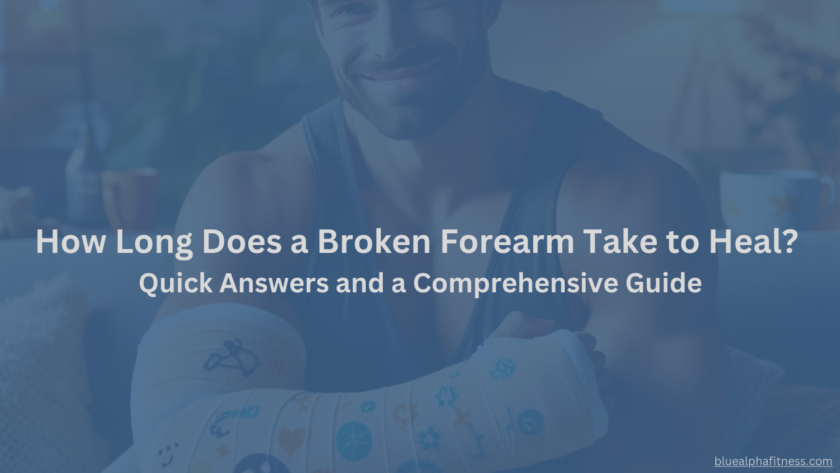Ever wondered how long it takes for a broken forearm to heal? Maybe you’re staring at your cast, frustrated, counting down the days until you can get back to normal life
It’s tough.
Not just the pain—but the waiting, the restrictions. It can feel like forever. And let’s be honest, you probably didn’t expect it to be this hard.
So, how long does a broken forearm take to heal?
On average, it takes anywhere from 6 to 12 weeks for a broken forearm to heal, depending on the type of fracture.
But it’s not just about time—it’s about what you do to speed up recovery and avoid setbacks.
This guide will walk you through everything you need to know to make sure your arm heals the right way.
Ready to dive in and get those answers? Let’s begin.
How Long Does a Broken Forearm Take to Heal? Explained
As mentioned earlier, a broken forearm typically takes 6 to 12 weeks to heal, though the exact duration depends on factors such as the type of fracture, age, diet, and overall health condition.
1. Understanding Forearm Fractures: A Quick Overview
When you break your forearm, it’s not just one bone that’s in trouble—there are two main bones at play: the radius and the ulna.
Depending on how the break happens, you might crack one, or if luck’s really not on your side, both.
A simple fall can lead to a “clean break,” or maybe you’ve got a more complex fracture from a sports injury. And each type of break has its own timetable for healing.
The tricky part? These different fractures don’t just heal at the same pace.
A clean break might wrap up faster than a complicated, multiple-fracture situation.
And that timeline directly affects how soon you can ditch the cast and get back to your daily routine.
2. Typical Healing Timeline for a Broken Forearm
The healing timeline for a broken forearm depends on the severity of the fracture.
Here’s a breakdown of what to expect based on different types of breaks.
· Mild Fractures:
Think of a simple, straightforward break—something that doesn’t shift the bones too much out of place.These tend to heal within 6 to 8 weeks.
They’re like the gold standard of fractures, the kind where the bone just needs time, a cast, and some patience.
· Moderate Fractures:
Here, the break is a bit more complicated.
Maybe the bones shifted slightly, or it’s a larger crack. These usually take 8 to 12 weeks.
It’s like waiting for that slow internet connection to load—it’s going to happen, just not as quickly as you’d hope.
· Severe or Multiple Fractures:
When your forearm decides to really put you through the wringer—multiple breaks or a bone that’s shattered—it could be 12 to 16 weeks before you’re in the clear.
These fractures need more care, possibly even surgery, before the healing truly starts.
3. Healing Stages for a Broken Forearm
Healing isn’t a one-shot deal; it’s a process, like baking a cake. You can’t rush it, but you can watch each stage unfold.
Here’s what to expect:
· Stage 1: Inflammation (Week 1-2)
Right after the break, your body kicks into gear with inflammation. It’s like an SOS signal to start the healing.
Expect swelling, bruising, and that all-too-familiar throbbing pain.
This phase might be the most uncomfortable, but it’s necessary. It’s your body’s way of saying, “Let’s get to work.”
· Stage 2: Soft Callus Formation (Weeks 2-4)
Next up, the soft callus.
Imagine a protective barrier starting to form over the break—like a bandage, but made by your own cells. It’s not yet solid, but it’s starting to pull the broken pieces back together.
You might notice that the pain’s easing up, and it’s a sign things are on the mend.
· Stage 3: Hard Callus Formation (Weeks 4-8)
Now the real repair work begins.
That soft callus toughens into a hard callus—think of it as scaffolding, holding everything in place.
It’s during this time that your forearm is most vulnerable to reinjury if you’re not careful.
Movement becomes easier, but don’t let it fool you. It’s not time to push your limits just yet.
· Stage 4: Bone Remodeling (Weeks 8-16+)
This final stage is where your body smooths out the rough edges. Your bone begins to remodel itself, aiming to get back to its original shape and strength.
Even if you’re out of the cast, your bone is still adjusting behind the scenes.
It’s like fine-tuning a car engine—getting all the little parts back in sync.
4. Factors That Can Affect Healing Time of a Broken Forearm
Factors that affect the healing time of a broken forearm include age, diet, and physical activity.
Younger individuals and those with healthier lifestyles typically recover faster.
Let’s break these factors down in more detail:
· Age:
Younger bones are like elastic—they bounce back quickly.
As you get older, though, it’s a different story. Healing can slow down as your bones lose a bit of that elasticity.
· Diet:
Your bones are hungry for calcium, vitamin D, and protein. Without these, it’s like trying to build a house without bricks.
Make sure you’re fueling your body with what it needs.
· Physical Activity Levels:
Too much movement too soon? That can set you back.
But being a total couch potato isn’t great either. Light movement as advised by your doctor can keep blood flowing to the area, helping to speed up healing.
· Smoking & Alcohol:
These can throw a wrench into the whole process.
Smoking restricts blood flow, and alcohol can slow down your body’s ability to form new bone. It’s like trying to run a race on a flat tire.
· Pre-Existing Conditions:
Diabetes, osteoporosis, and other conditions can make your bones more fragile or slow down the healing process.
It’s worth discussing these with your doctor to know what to expect.
· Stress Levels:
High levels of stress can slow down your body’s healing response.
Managing stress through relaxation techniques, such as meditation or light exercise, may help improve recovery.
· Medications:
Certain medications, like steroids or blood thinners, can affect bone healing.
Be sure to discuss your medications with your doctor to ensure they aren’t hindering the process.
5. How to Know If Your Broken Forearm Is Healing Properly
Signs that your broken forearm is healing properly include decreasing pain, reduced swelling, and improved flexibility in your wrist and fingers.
However, if you’re experiencing worsening pain or persistent swelling, these may be warning signs of complications.
To help you track your recovery, let’s explore the positive signs to look for and the red flags that may require attention.
Positive Signs:
- Decreasing Pain: Pain that gradually lessens over time is a reassuring sign. While some discomfort is normal, it should improve, not worsen.
- Reduced Swelling: Swelling should steadily go down as the healing progresses. Initially, it may be significant, but you’ll notice a reduction after the first few days to weeks.
- Improved Range of Motion: As healing advances, you should see increased flexibility in your wrist, hand, and fingers. Even if the forearm itself remains stiff, your ability to move the surrounding areas indicates progress.
- Bone Stability: Feeling the forearm becoming more stable, especially after the first few weeks, is a positive indicator that the bone is knitting properly.
Red Flags:
- Increasing Pain: If your pain is intensifying instead of decreasing, it’s a sign that something might be wrong. Persistent or sharp pain, especially after the initial few weeks, can indicate complications.
- Prolonged or Worsening Swelling: Swelling that does not go down or worsens over time can suggest issues such as infection or improper alignment of the bones.
- Tight Cast or Brace: If you feel like your cast or splint is too tight, causing numbness or severe discomfort, it could mean there’s excessive swelling that’s cutting off circulation—this requires immediate attention.
- Instability or Grinding Sensations: If you feel that the bones are shifting, grinding, or unstable, this could be a sign of improper alignment or failed healing. Any unusual movement in the forearm area should prompt a visit to your doctor.
When to Contact Your Doctor:
If you experience any of the red flags mentioned above, don’t hesitate to consult your healthcare provider.
It’s better to address potential issues early to avoid complications such as improper bone healing, which could lead to long-term dysfunction or the need for further medical intervention.
What Are the Common Types of Forearm Fractures?
The common types of forearm fractures include greenstick, transverse, comminuted, and open fractures, each affecting treatment options and recovery times.
Understanding these types can help you navigate your recovery more effectively.
1. Greenstick Fracture:
This is most common in kids, where the bone bends and cracks but doesn’t break all the way through—like bending a green twig.
While recovery can be quicker, usually around 6 to 8 weeks, it still requires careful monitoring to ensure proper healing.
2. Transverse Fracture:
A straight-across break, like snapping a pencil.
It’s easy to spot on an X-ray, and depending on how aligned the bones are, you might just need a cast, though in some cases, pins are required to keep everything in place.
These fractures typically heal within 8 to 12 weeks.
3. Comminuted Fracture:
Picture a bone shattered into multiple pieces, like broken glass.
This severe injury often requires surgery to realign and stabilize the bone. Given the complexity, recovery can take 12 to 16 weeks or more.
4. Open (Compound) Fracture:
This occurs when the bone breaks through the skin, posing a risk of infection.
Immediate surgery is usually needed to clean and stabilize the injury.
The recovery time for open fractures varies but often falls in the range of 12 to 16 weeks, with additional precautions to prevent complications.
Each type of fracture comes with its own set of challenges, but understanding which one you have helps manage expectations and gives you a clearer picture of the road to recovery.
Can You Speed Up the Healing Process of a Broken Forearm?
No, you can’t magically speed up the healing time of a broken forearm, but you can create conditions that support a faster recovery through proper nutrition, rest, and physical therapy.
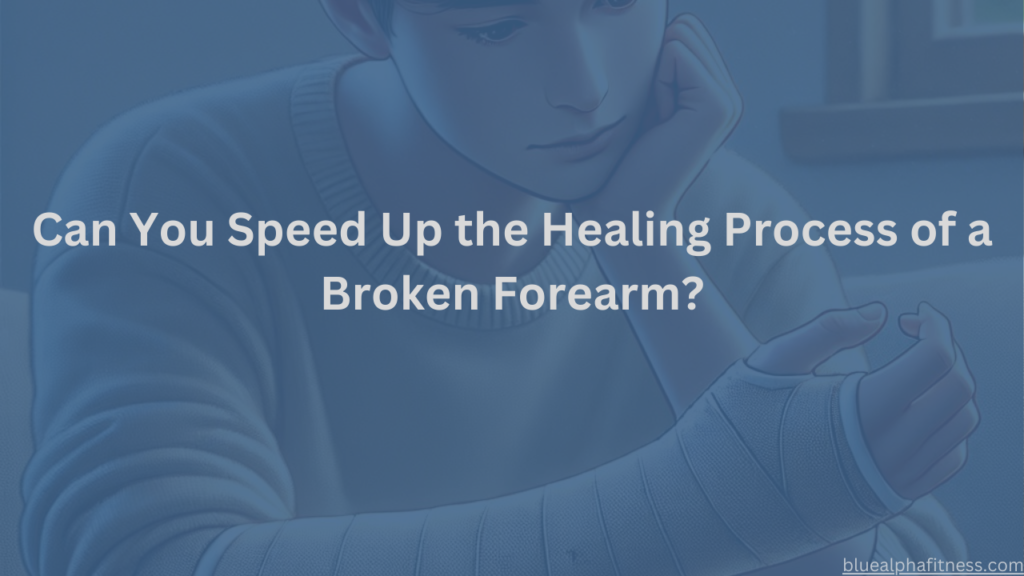
Let’s explore the steps you can take to help a broken forearm heal more efficiently:
1. Proper Nutrition:
Think of it as giving your bones a repair kit.
Foods rich in calcium, like dairy and leafy greens, and vitamin D from sunlight or supplements can do wonders.
Protein is your building block—eggs, lean meat, and beans are your friends.
2. Physical Therapy:
Once your doctor gives the green light, physical therapy is your ticket back to mobility.
It helps strengthen the muscles around the bone and improves flexibility. But don’t overdo it; you don’t want to end up back at square one.
3. Supplements:
Some studies suggest glucosamine, collagen, and magnesium may support bone health. But always chat with your doctor before adding anything new to your regimen.
It’s tempting to try every pill on the shelf, but more isn’t always better.
4. Rest and Elevation:
This might sound counterintuitive, but less can sometimes be more.
Letting your body rest means it can direct energy toward the healing process.
Elevating your arm can reduce swelling, too, making things a little more comfortable while your bones do their thing.
And about those old wives’ tales—wrapping a broken bone in cabbage leaves or taking mega doses of vitamins? Skip those. Science is your best bet here.
When Should You Consider Surgery for a Broken Forearm?
You should consider surgery for a broken forearm when bones are misaligned, there’s an open fracture, or you have multiple fractures that need realignment.
Surgery can ensure proper healing and reduce future complications.
1. Misaligned Bones:
If the bones have shifted significantly, surgery can help realign them using plates, screws, or rods.
Think of it like using scaffolding to stabilize a building while it’s being repaired.
2. Open Fractures:
When the bone pokes through the skin, surgery is a must to clean the wound and reduce infection risk. It’s a tough situation, but with prompt treatment, it can heal just fine.
3. Multiple Fractures:
If your forearm looks like a jigsaw puzzle, surgical intervention might be the only way to put all the pieces back together properly.
It’s a longer recovery, but it helps ensure the bones heal the way they should.
Your doctor will weigh the risks and benefits, and sometimes the decision isn’t clear-cut.
It’s about finding the approach that gives you the best chance of getting back to normal without complications.
When Should You Start Physical Therapy for a Broken Forearm?
You should start physical therapy for a broken forearm once your doctor confirms that the bone is stable, typically 4-6 weeks after the injury.
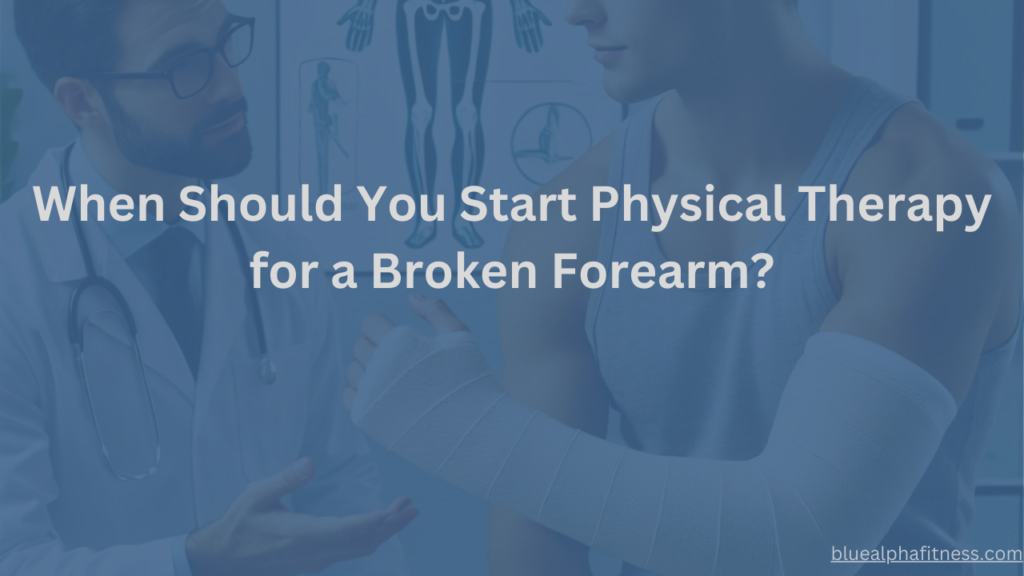
The timing depends on the type of fracture and whether surgery was needed.
1. What to Expect When Starting Physical Therapy for a Broken Forearm
Starting physical therapy for a broken forearm is a gradual process.
Here’s what you can expect during your sessions:
· Range-of-Motion Exercises:
In the early stages, you’ll work on gentle exercises to regain movement in your wrist, elbow, and fingers. These movements help reduce stiffness without straining the healing forearm.
· Steady Progress:
Don’t expect quick results.
Physical therapy is about consistent improvement over time. Your muscles and joints are relearning their function after weeks of immobility.
· Stiffness and Discomfort:
It’s normal to experience some stiffness or discomfort as your body adjusts to movement again.
These sensations are temporary and a natural part of the recovery process.
2. Benefits of Physical Therapy for Restoring Mobility and Strength to a Broken Forearm
Why does physical therapy matter so much?
When your arm is in a cast or splint for weeks, your muscles start to weaken, and your joints can stiffen up. Physical therapy helps to:
· Restore Mobility:
After weeks of immobility, your wrist and elbow might feel like they’ve forgotten how to bend.
Therapy helps to gently stretch and move those joints, making daily activities feel easier.
· Rebuild Strength:
Your forearm muscles have been on vacation, and now they need to get back to work. Strengthening exercises target these muscles so they can support the healing bone.
· Improve Circulation:
Gentle movement can help boost blood flow to the injury site, speeding up the recovery process and reducing any lingering swelling.
3. Tips for Gentle Exercises to Maintain Muscle Strength While the Forearm Heals
Keeping your muscles engaged during the healing process is key, even when you’re limited by a cast or splint.
While you should always get your doctor’s approval before starting any exercise, here are a few gentle movements to try:
· Finger Squeezes:
Squeezing a stress ball or a rolled-up towel can keep the small muscles in your hand and fingers active, maintaining circulation and preventing stiffness.
How to do it: Hold the stress ball or towel in your hand and gently squeeze for about 5 seconds, then release. Repeat 10-15 times, a few times throughout the day.
This keeps your grip strength up without stressing the healing bones.
· Wrist Bends:
Wrist movements keep the joint from stiffening up, which is common when your arm is immobilized. It helps maintain flexibility in the wrist area, which will make later rehab easier.
How to do it: Rest your forearm on a table with your hand hanging over the edge. Slowly bend your wrist up and down, making sure not to force any movements. Aim for 2 sets of 10 gentle bends, twice a day.
It’s a small action but can make a big difference in keeping your range of motion.
· Shoulder Rolls:
It’s easy to overlook the shoulder, but maintaining flexibility in this joint is crucial, especially since the arm and shoulder are so interconnected.
Keeping your shoulder loose can prevent stiffness that could affect the entire arm.
How to do it: Sit or stand comfortably and slowly roll your shoulders forward and backward in a circular motion. Do 10 rolls in each direction, 2-3 times a day.
This can help improve circulation and prevent tension from building up.
These exercises might seem minor, but they play a crucial role in keeping your muscles engaged while your bones do their thing.
The key is to focus on slow, gentle movements that don’t strain the healing area.
It’s all about being patient and gentle with your body, laying the groundwork for a smoother recovery when you’re ready for more intensive rehab.
How to Care for a Broken Forearm at Home
To care for a broken forearm at home, manage pain with ice, elevation, and medication. Keep your cast dry, check for tightness, and avoid any activity that risks re-injury.
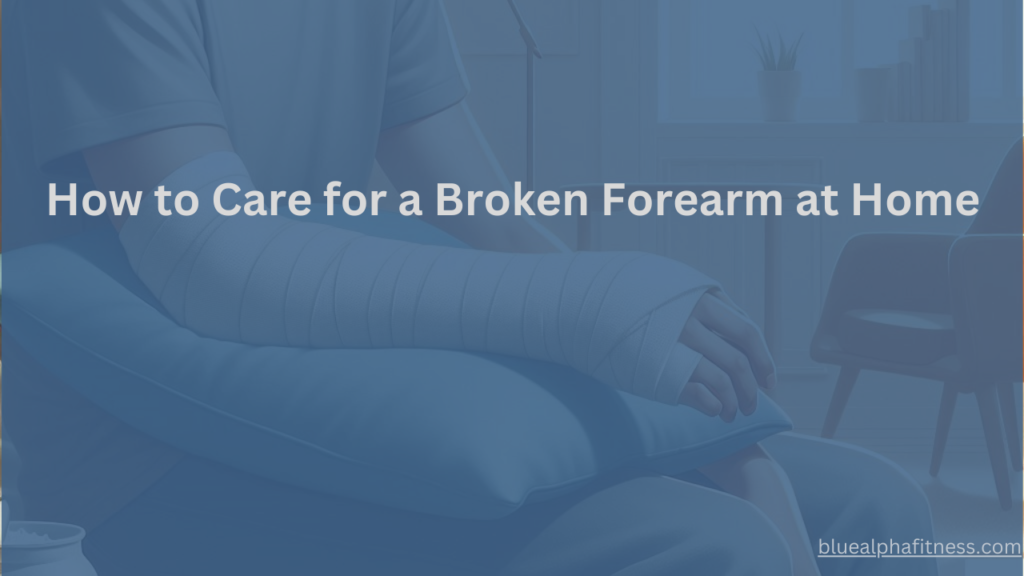
These steps will support healing and reduce discomfort.
1. Tips for Managing Pain and Discomfort with Proper Care
Pain is an unfortunate part of a broken forearm, but there are ways to manage it:
· Ice It:
Applying an ice pack to the area (make sure it’s not directly on the skin) can help reduce swelling and numb the pain.
· Keep It Elevated:
Propping your arm up with pillows can reduce throbbing by limiting blood flow to the area. Think of it like letting the pressure out of a balloon.
· Over-the-Counter Pain Relievers:
Medications like ibuprofen or acetaminophen can help manage pain in the early days, but always follow your doctor’s advice on dosage.
2. Guidelines for Caring for a Cast or Splint
A cast or splint is like a cocoon for your healing bones, but it needs some TLC too:
· Keep It Dry:
Moisture can weaken the cast and irritate your skin. Use a waterproof cover when showering.
· Avoid Itching Inside the Cast:
As tempting as it is, don’t stick objects down there to scratch an itch. Instead, use a blow dryer on the cool setting to blow some air inside.
· Check for Tightness:
If your fingers feel numb or you notice increased swelling, the cast might be too tight.
Don’t ignore it—contact your doctor to make sure everything’s right.
3. Precautions to Prevent Re-Injury During the Healing Process
Re-injury is a real concern when you’re just getting back on your feet.
Here’s how to stay safe:
· Avoid Heavy Lifting:
Even if you’re feeling better, don’t rush into lifting weights or heavy objects. It’s like opening a present too early—wait until the time is right.
· Be Careful on Slippery Surfaces:
Falls are the enemy. Be extra cautious on wet or uneven surfaces, especially while adjusting to a splint or cast.
· Follow Doctor’s Orders:
If they say no physical activity, they mean it. Pushing your limits can set you back weeks.
4. How to Sleep with a Broken Forearm to Avoid Strain
Sleeping with a broken forearm can be a challenge. Here’s how to make it more comfortable:
· Sleep on Your Back:
If possible, try sleeping on your back with your arm elevated on pillows. It helps prevent rolling over and puts less pressure on the injury.
· Use a Body Pillow:
A body pillow can cradle your arm and keep it in a more stable position.
· Keep Your Cast Supported:
Make sure your cast or splint is fully supported, whether you’re using extra pillows or a folded blanket. You want to avoid waking up with a sore arm from an awkward angle.
What Happens If a Broken Forearm Doesn’t Heal Properly?
If a broken forearm doesn’t heal properly, it can lead to delayed healing or a nonunion fracture, causing ongoing pain, movement issues, or visible deformities.
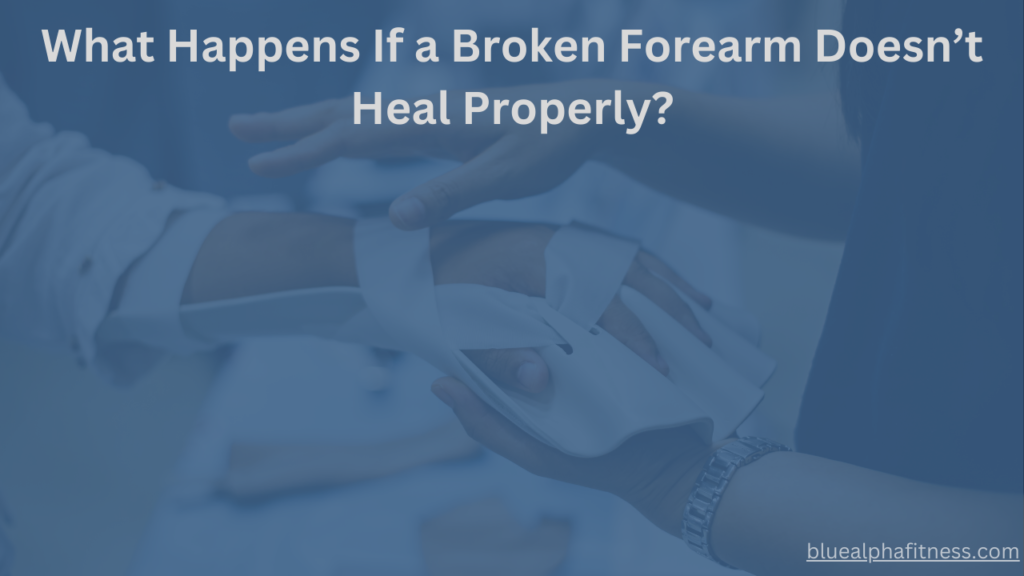
Early treatment is crucial to avoid complications and restore full function.
What Are Delayed Healing and Nonunion Fractures?
In some cases, bones take longer to heal or don’t heal at all.
When healing is slower than expected, it’s called delayed healing. If the bone fails to fuse completely, it’s known as a nonunion fracture, which may require additional treatment.
Symptoms Indicating Improper Healing of a Broken Forearm
So how do you know if your forearm’s not healing as it should?
Here’s what to watch for:
1. Persistent Pain:
It’s normal for pain to linger, but it should gradually lessen over time. If the ache stays the same or worsens, that’s a red flag.
2. Movement Issues:
A lack of improvement in range of motion can be a sign that things aren’t going smoothly. Maybe your wrist is still as stiff as it was weeks ago.
3. Visible Deformity:
If the arm looks crooked or you notice a bump where the bone should be smooth, it could indicate improper healing.
Treatment Options for Nonunion Fractures, Including Possible Surgical Interventions
A nonunion fracture often requires more than just waiting it out. Here’s what might be on the table:
1. Bone Stimulation:
Doctors can use ultrasound or electrical stimulation to encourage the bone to heal.
It’s like a little nudge to get things moving.
2. Bone Grafting:
In some cases, a bone graft might be needed to provide a fresh supply of bone cells to the area.
This involves taking bone tissue from another part of your body or using a synthetic option.
3. Surgery for Realignment:
If the bones aren’t aligning properly, surgery might be needed to put everything back in place.
Plates, rods, or screws are used to stabilize the bones while they heal.
Importance of Follow-Up Appointments with a Healthcare Provider
Follow-up appointments aren’t just a formality—they’re your best chance to catch any issues early.
Your doctor will monitor the progress with X-rays, check how the bone is mending, and make adjustments to your treatment plan.
Even if things feel fine, these appointments can catch problems before they become bigger setbacks.
It’s like getting your car checked before a long road trip—better to be safe than stuck on the side of the road.
FAQ: How Long Does a Broken Forearm Take to Heal? Your Common Questions Answered
Now, let’s dive into some of the most common questions about healing a broken forearm.
Whether you’re wondering about recovery times, managing pain, or how to speed up the healing process, this FAQ has got you covered with concise, expert answers to help you through your recovery journey.
1. How long does it take for a broken arm to stop hurting?
It takes about 2 to 4 weeks for a broken arm to stop hurting. However, discomfort may persist during the healing process, especially with movement.
2. How long does it take to get full range of motion after a broken arm?
It takes around 6 to 8 weeks to regain full range of motion after a broken arm. Physical therapy may be necessary to restore flexibility and strength.
3. How long does it take to fix a broken forearm?
It takes about 6 to 8 weeks to fix a broken forearm. Healing time may vary depending on the severity of the fracture and the type of treatment used.
4. How long does it take a broken arm to heal without surgery?
It takes 6 to 12 weeks for a broken arm to heal without surgery. The exact time depends on the type of fracture and how well the bone is immobilized during healing.
5. How long to regain muscle after a broken arm?
It takes about 2 to 6 months to regain muscle after a broken arm. Recovery time can vary based on the extent of muscle loss and the intensity of rehabilitation exercises.
6. What happens after 2 weeks of a fracture?
After 2 weeks of a fracture, initial bone healing begins, with the formation of soft callus around the break. Swelling and pain may decrease, but the bone remains fragile.
7. What is the longest time for a broken bone to heal?
The longest time for a broken bone to heal can be up to 6 months or more, especially in severe cases or with complications like delayed union. Factors such as age, health, and the bone affected play a role in healing time.
8. Can a broken arm heal in 2 weeks?
A broken arm cannot heal in 2 weeks. Most fractures require at least 6 weeks for significant healing.
9. Can an injury take 2 years to heal?
Yes, an injury can take 2 years to heal, particularly if it involves severe damage, complications, or if post-injury rehabilitation is slow.
10. What are the signs that a broken bone is healing?
Signs that a broken bone is healing include reduced pain, decreased swelling, and increased mobility. X-rays can confirm bone formation around the fracture site.
11. When does a broken bone stop hurting?
A broken bone generally stops hurting after 2 to 4 weeks as the initial healing process begins. Pain can persist longer if the injury is severe or complications arise.
12. Should a broken arm still hurt after 4 weeks?
A broken arm may still have some pain after 4 weeks, but it should be improving. Persistent or worsening pain may indicate complications, so medical advice may be needed.
13. Can a broken arm cause permanent damage?
A broken arm can cause permanent damage if it does not heal properly or if nerves or blood vessels are affected. Proper treatment and rehabilitation are key to preventing long-term issues.
14. Do you ever fully recover from a broken arm?
You can fully recover from a broken arm with proper treatment and rehabilitation. However, some individuals may experience lingering stiffness or weakness.
15. Can a broken arm go back to normal?
A broken arm can go back to normal after healing, especially with proper physical therapy. It may take time to regain full strength and flexibility.
16. Will a forearm fracture heal on its own?
A forearm fracture can heal on its own if properly immobilized. However, severe fractures may require medical intervention for proper alignment.
Stronger Every Day: Recovering from a Broken Forearm
When you’re facing a broken forearm, it’s tough not to feel like the clock is ticking too slowly. You might find yourself wondering, “Why isn’t this healing faster? Will I be able to lift, drive, or play sports like before?”
It’s okay to feel frustrated or anxious—those feelings are a part of the healing process, too.
But remember, recovery isn’t just about time passing; it’s about the strength you build along the way.
With each step you take, from following your doctor’s advice to embracing those gentle exercises, you’re inching closer to getting back to the life you love.
This guide has your back, from knowing when to start physical therapy to managing those sleepless nights.
So, trust in your body’s ability to heal and be patient with yourself.
You’ve got this, and soon, you’ll be stronger than ever.
